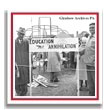|

The Métis are a dynamic people who have encountered many
changes following the Fur Trade. Many Métis settled and focused
their agricultural talents on a mixed farming approach. Many had
fields, livestock, and gardens in addition to the hunting and
fishing that occurred throughout the year. Life was hard, but
life was good. When the Great Depression hit, the Métis were
increasingly displaced by non-Aboriginal settlers who were
pursuing good crop lands. Displacement led entire Métis
communities into states of disease, illiteracy, and deepening
poverty. Throughout the west, the seeds of political and
cultural power were taking root as a result of the dire
situation of Métis. Discussion in the community led to the need
for organization.
Alberta is a perfect example of how the Métis gained momentum
using organizational skill and determination. Local Métis
meetings were held in St. Paul and in St. Albert. In addition,
prominent Métis advocate Adrian Hope traveled to Calgary to meet
with other Métis to gauge their interest. Métis political
activism resulted in the formation of L’Association des Métis
D’Alberta et des Territories du Nord Ouest on 28 December 1932.
This group of activists for the Métis and their grievances was
led by Métis political activists Joseph Dion, Malcolm Norris,
Felix Callihoo, Pete Tomkins, and James Brady. These men formed
the first governing body of the Métis, and this organization
later was named the Métis Nation Association of Alberta. The
lobbying of this group led to the provincial government’s
response of appointing the Ewing Commission in 1934 that would
ultimately lead to the Population Betterment Act of 1938.
The Population Betterment Act established Métis agricultural
settlement throughout central and northern Alberta. Initially,
twelve Métis settlements were set aside: Peavine, Caslan, Cold
Lake, East Prairie, Elizabeth, Fishing Lake, Gift Lake, Kikino,
Paddle Prairie, Touchwood, Marlboro, and Wolf Lake. Currently,
there are eight remaining settlements: Buffalo Lake, East
Prairie, Elizabeth, Fishing Lake, Gift Lake, Kikino, Paddle
Prairie, and Peavine.
In 1982, the Métis were successful in gaining national
recognition in the Constitution of Canada. Métis were reaffirmed
as a part of the Aboriginal definition. Section 35 of the
Constitution recognizes Aboriginal peoples as "Indians, Inuit
and Métis." This provided Métis people with distinct rights and
constitutional protection. With the exception of Alberta – which
has set aside land for self-governing Metis Settlements, and has
signed an interim agreement with Metis Nation of Alberta to
legally permit year-round harvesting to Métis rights-holders –
the Canadian government and other provinces have done little to
legally recognize the Aboriginal rights of the Métis.
There have been a number of legal challenges that have tested
and challenged the constitutional commitment made to Métis in
1982. For example, in December 1998, a northern Ontario Métis
was charged with hunting without a license. Ontario Judge
Charles Vaillancourt acquitted this person on the grounds that
Métis have Aboriginal hunting rights. This case was a precursor
to another legal challenge that went all the way to the Supreme
Court of Canada. In 1993, Steve Powley and his son Roddy were
arrested in southern Ontario for hunting moose without a license
and outside the provincial hunting season. They argued that they
were acting within their constitutional rights to hunt for food.
In section 35, the term ‘Métis’ refers to distinctive peoples
who, in addition to their mixed ancestry, developed their own
customs, way of life, and recognizable group identity separate
from their Indian or Inuit and European forebears." On 19
September 2003, the Supreme Court of Canada ruled that indeed,
as a Métis, Powley was exercising his Aboriginal rights. The
highest court in the land affirmed what Métis have long known
they are a distinct Aboriginal people with constitutional
rights.
|
 Heritage Community Foundation Presents
Heritage Community Foundation Presents




















